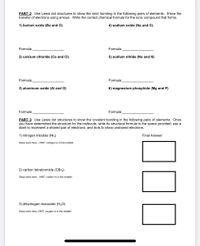
Chemistry
10th Edition
ISBN: 9781305957404
Author: Steven S. Zumdahl, Susan A. Zumdahl, Donald J. DeCoste
Publisher: Cengage Learning
expand_more
expand_more
format_list_bulleted
Question

Transcribed Image Text:PART 2: Use Lewis dot structures to show the ionic bonding in the following pairs of elements. Show the
transfer of electrons using arrows. Write the correct chemical formula for the ionic compound that forms.
1) barium oxide (Ba and O)
4) sodium oxide (Na and O)
Formula:
Formula:
2) calcium chloride (Ca and CI)
5) sodium nitride (Na and N)
Formula:
Formula:
3) aluminum oxide (Al and O)
6) magnesium phosphide (Mg and P)
Formula:
Formula:
PART 3: Use Lewis dot structures to show the covalent bonding in the following pairs of elements. Once
you have determined the structure for the molecule, write its structural formula in the space provided; use a
dash to represent a shared pair of electrons, and dots to show unshared electrons.
1) nitrogen triiodide (NI3)
Final Answer:
Show work here...HINT: nitrogen is in the middle!
2) carbon tetrabromide (CBr4)
Show work here...HINT: carbon is in the middle!
3) dihydrogen monoxide (H,O)
Show work here.HINT: oxygen is in the middle!
Expert Solution
This question has been solved!
Explore an expertly crafted, step-by-step solution for a thorough understanding of key concepts.
This is a popular solution
Trending nowThis is a popular solution!
Step by stepSolved in 4 steps with 2 images

Knowledge Booster
Learn more about
Need a deep-dive on the concept behind this application? Look no further. Learn more about this topic, chemistry and related others by exploring similar questions and additional content below.Similar questions
- For each row in the table below, decide whether the pair of elements will form a molecular or ionic compound. If they will, then enter the chemical formula of the compound. If the elements will form more than one compound, enter the compound with the fewest total number of atoms. You may assume all chemical bonds are single bonds, not double or triple bonds. element #1 nitrogen oxygen magnesium element #2 compound formed? chemical formula O ionic O molecular O neither bromine fluorine oxygen O O O O O O O O O O ionic O molecular O neither O ionic O molecular O neither X Sarrow_forwardHello! I'm not sure what to put in the 3 blank spots.arrow_forwardPredicting the compound formed by two main group elements For each row in the table below, decide whether the pair of elements will form a molecular or ionic compound. If they will, then enter the chemical formula of the compound. If the elements will form more than one compound, enter the compound with the fewest total number of atoms. You may assume all chemical bonds are single bonds, not double or triple bonds. element #1 element #2 compound formed? chemical formula O lonic potassium lithium molecular O neither lonic neon argon O molecular neither ionic potassium fluorine molecular neither Explanation Check 2021 McGraw-Hill Education. All Rights Reserved. Terms of Use I Privacy I Accessi MacBook Pro %2$ 4 1 2 3 5 6 7 8 Q W E T Y F J C V B alt alt optlon command MOSISO command option Varrow_forward
- Answer the following questions about the polyatomic ion phosphate(molar mass 94.97g/mol). 1)What is the charge of the phosphate polyatomic ion? 2)Does the polyatomic ion have multiple resonance structures? 3)If you had 12g of phosphate,how many oxygen atoms would you have?arrow_forwardPlease help me with this question (Explain). What would be the correct answer?arrow_forward
arrow_back_ios
arrow_forward_ios
Recommended textbooks for you
 ChemistryChemistryISBN:9781305957404Author:Steven S. Zumdahl, Susan A. Zumdahl, Donald J. DeCostePublisher:Cengage Learning
ChemistryChemistryISBN:9781305957404Author:Steven S. Zumdahl, Susan A. Zumdahl, Donald J. DeCostePublisher:Cengage Learning ChemistryChemistryISBN:9781259911156Author:Raymond Chang Dr., Jason Overby ProfessorPublisher:McGraw-Hill Education
ChemistryChemistryISBN:9781259911156Author:Raymond Chang Dr., Jason Overby ProfessorPublisher:McGraw-Hill Education Principles of Instrumental AnalysisChemistryISBN:9781305577213Author:Douglas A. Skoog, F. James Holler, Stanley R. CrouchPublisher:Cengage Learning
Principles of Instrumental AnalysisChemistryISBN:9781305577213Author:Douglas A. Skoog, F. James Holler, Stanley R. CrouchPublisher:Cengage Learning Organic ChemistryChemistryISBN:9780078021558Author:Janice Gorzynski Smith Dr.Publisher:McGraw-Hill Education
Organic ChemistryChemistryISBN:9780078021558Author:Janice Gorzynski Smith Dr.Publisher:McGraw-Hill Education Chemistry: Principles and ReactionsChemistryISBN:9781305079373Author:William L. Masterton, Cecile N. HurleyPublisher:Cengage Learning
Chemistry: Principles and ReactionsChemistryISBN:9781305079373Author:William L. Masterton, Cecile N. HurleyPublisher:Cengage Learning Elementary Principles of Chemical Processes, Bind...ChemistryISBN:9781118431221Author:Richard M. Felder, Ronald W. Rousseau, Lisa G. BullardPublisher:WILEY
Elementary Principles of Chemical Processes, Bind...ChemistryISBN:9781118431221Author:Richard M. Felder, Ronald W. Rousseau, Lisa G. BullardPublisher:WILEY

Chemistry
Chemistry
ISBN:9781305957404
Author:Steven S. Zumdahl, Susan A. Zumdahl, Donald J. DeCoste
Publisher:Cengage Learning

Chemistry
Chemistry
ISBN:9781259911156
Author:Raymond Chang Dr., Jason Overby Professor
Publisher:McGraw-Hill Education

Principles of Instrumental Analysis
Chemistry
ISBN:9781305577213
Author:Douglas A. Skoog, F. James Holler, Stanley R. Crouch
Publisher:Cengage Learning

Organic Chemistry
Chemistry
ISBN:9780078021558
Author:Janice Gorzynski Smith Dr.
Publisher:McGraw-Hill Education

Chemistry: Principles and Reactions
Chemistry
ISBN:9781305079373
Author:William L. Masterton, Cecile N. Hurley
Publisher:Cengage Learning

Elementary Principles of Chemical Processes, Bind...
Chemistry
ISBN:9781118431221
Author:Richard M. Felder, Ronald W. Rousseau, Lisa G. Bullard
Publisher:WILEY